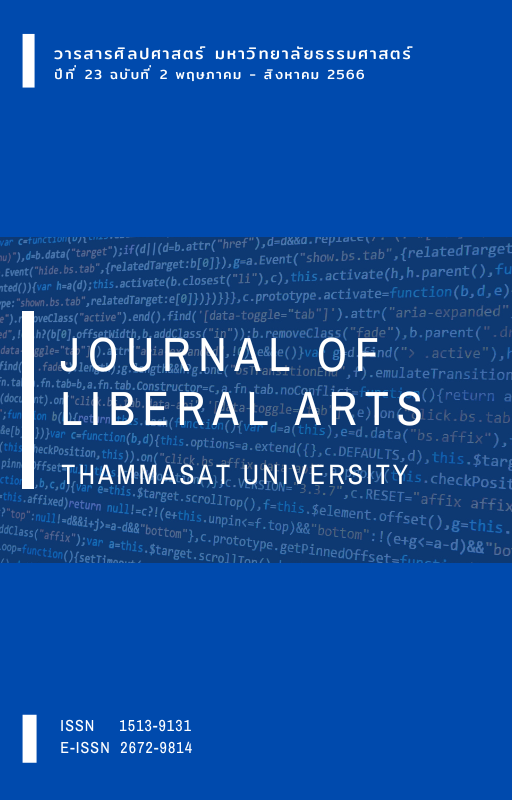การวิเคราะห์เชิงพื้นที่ลักษณะภูมินามของวัดในจังหวัดนครศรีธรรมราชด้วยระบบสารสนเทศภูมิศาสตร์
Main Article Content
บทคัดย่อ
ภูมินามสะท้อนให้เห็นถึงภูมิทัศน์วัฒนธรรมและเป็น “ซากดึกดำบรรพ์ที่มีชีวิต” ที่ช่วยในการศึกษาพัฒนาการทางประวัติศาสตร์และวัฒนธรรมของพื้นที่ การศึกษาครั้งนี้มีวัตถุประสงค์ 1) เพื่อวิเคราะห์แบบรูปการกระจายทางพื้นที่ของภูมินามของวัดในจังหวัดนครศรีธรรมราชตามยุคสมัย และ 2) เพื่อวิเคราะห์ความสัมพันธ์ระหว่างภูมินามของวัดกับปัจจัยแวดล้อมทางกายภาพด้วยระบบสารสนเทศภูมิศาสตร์ (GIS) โดยใช้วิธีการประมาณความหนาแน่นเชิงพื้นที่แบบเคอร์เนล (KDE) ในการวิเคราะห์แบบรูปการกระจายทางพื้นที่ของภูมินามของวัดเหล่านี้ จำนวน 652 วัด จากนั้นวิเคราะห์ความสัมพันธ์ระหว่างภูมินามของวัดเฉพาะประเภทลักษณะภูมิศาสตร์กับสภาพแวดล้อมทางกายภาพ 5 ประการ คือ ความสูง ความชัน ทิศทางของความลาดชัน ระยะห่างจากแม่น้ำหลัก และระยะห่างจากอำเภอเมือง ผลการศึกษาพบว่าลักษณะภูมินามของวัดส่วนใหญ่ร้อยละ 38.34 เป็นภูมินามประเภทลักษณะภูมิศาสตร์โดยเฉพาะประเภทแหล่งน้ำ โดยที่ภูมินามของวัดในสมัยสุโขทัยมีชื่อที่สัมพันธ์กับลักษณะคุณสมบัติเป็นส่วนใหญ่ ส่วนภูมินามของวัดในสมัยอยุธยา สมัยธนบุรี และสมัยรัตนโกสินทร์เป็นประเภทลักษณะภูมิศาสตร์ ทั้งนี้ แบบรูปการกระจายทางพื้นที่ของวัดแตกต่างกันในแต่ละยุคสมัย โดยส่วนใหญ่มีการกระจายแบบเกาะกลุ่มและกระจุกตัวหนาแน่นบริเวณที่ราบชายฝั่งด้านตะวันออกของจังหวัด ส่วนผลการศึกษาความสัมพันธ์ระหว่างภูมินามของวัดเฉพาะประเภทลักษณะภูมิศาสตร์กับสภาพแวดล้อมทางกายภาพ พบว่าวัดส่วนใหญ่ตั้งอยู่บริเวณที่ราบและที่ราบต่ำที่มีความลาดชันต่ำ และทิศทางของความลาดชันอยู่ทางทิศตะวันออกเป็นหลัก ซึ่งวัดเหล่านี้ส่วนใหญ่ตั้งอยู่ห่างจากศูนย์กลางเมือง (อำเภอเมือง) และแม่น้ำสายหลัก คือ แม่น้ำ ตาปีและแม่น้ำปากพนัง มากกว่า 10 กิโลเมตรขึ้นไป
Downloads
Article Details

อนุญาตภายใต้เงื่อนไข Creative Commons Attribution-NonCommercial-NoDerivatives 4.0 International License.
เอกสารอ้างอิง
กรรณิการ์ ตันประเสริฐ, ภูธร ภูมะธน, แสงอรุณ กนกพงศ์ชัย, ประทุม ชุ่มเพ็งพันธุ์, ต้วน ลี่เซิง, ชวลิต อังวิทยาธร, ทิวา ศุภจรรยา, และ สุกรี เจริญสุข. (2540). นครศรีธรรมราช: กรณีศึกษา การตั้งถิ่นฐานที่กรุงชิงและพรุควนเคร็ง, จีน: ประวัติศาสตร์โบราณคดี ผู้คนและวัฒนธรรม. สภามหาวิทยาลัยหัวเฉียวเฉลิมพระเกียรติ.
ขวัญชนก นัยจรัญ. (2560). การศึกษาคุณค่าของภูมินามในตำบลเมืองบางขลัง อำเภอสวรรคโลก จังหวัดสุโขทัย. วารสารมนุษยศาสตร์ มหาวิทยาลัยนเรศวร, 14(1), 61-72.
น้องนุช มณีอินทร์. (2543). การปรับเปลี่ยนของชื่อหมู่บ้านในจังหวัดเชียงใหม่ [วิทยานิพนธ์ปริญญามหาบัณฑิต, จุฬาลงกรณ์มหาวิทยาลัย]. Chulalongkorn University Intellectual Repository. http://cuir.car.chula.ac.th/handle/123456789/5941
ประพนธ์ เรืองณรงค์. (2558). ชื่อบ้านนามเมืองภาษามลายูในคาบสมุทรภาคใต้ของไทย. วารสารดำรงวิชาการ, 14(1), 11-32.
พระศรีรัตนมุนี, บุญเหลือ ใจมโน, และ สนม ครุฑเมือง. (2562). ภูมินามของวัดในประเทศไทยและประเทศสาธารณรัฐประชาธิปไตยประชาชนลาว: การเปรียบเทียบการตั้งชื่อ. วารสารบัณฑิตศึกษามหาจุฬาขอนแก่น, 6(4), 621-638.
วิเชียร ณ นคร, สมพุทธ ธุระเจน, ชวน เพชรแก้ว, ฉัตรชัย ศุกระกาญจน์, และ ปรีชา นุ่นสุข. (2523). นครศรีธรรมราชของเรา. บางกอกสาส์น.
สำนักงานสถิติแห่งชาติ. (2564). จำนวนประชากรจากการทะเบียน จำแนกตามอายุ เพศ ภาค และจังหวัด พ.ศ. 2564. สำนักงานสถิติแห่งชาติ. http://statbbi.nso.go.th/staticreport/page/sector/th/01.aspx
สุพัตรา จิรนันทนาภรณ์ และ อัญชลี สิงห์น้อย. (2548). โครงสร้างทางภาษาภูมินามของหมู่บ้านในจังหวัดพิษณุโลก. วารสารภาษาและภาษาศาสตร์, 23(2), 75-94.
สำนักงานพระพุทธศาสนาแห่งชาติ, กลุ่มเทคโนโลยีสารสนเทศ. (2564). ระบบทะเบียนวัด. สำนักงานพระพุทธศาสนาแห่งชาติ. http://binfo.onab.go.th/Temple/Temple-List-view.aspx
โอฬาร รัตนภักดี และ วิมลศิริ กลิ่นบุบผา. (2552). ภูมินามของหมู่บ้านในจังหวัดลำปาง. วารสารคณะอักษรศาสตร์ มหาวิทยาลัยศิลปากร, 31(2), 26-61.
Adab, N., & Datang, F. A. (2021). The origin of beach names in Tanjungsari: Toponymy studies. International Review of Humanities Studies, 6(1). 594-614.
Areeprachakun, P., & Cheewinsiriwat, P. (2016). A GIS study of toponyms in Nan province, Thailand. วารสารสังคมศาสตร์ มหาวิทยาลัยศรีนครินทรวิโรฒ, 19, 170-184.
Boas, F. (1964). On geographical names of the kwakiutl. In D. Hymes (Ed.), Language in Culture and Society (pp. 171-181). Harper and Row.
Conedera, M., Vassere, S., Neff, C., Meurer, M., & Krebs, P. (2007). Using toponymy to reconstruct past land use: A case study of ‘brüsáda’ (burn) in southern Switzerland. Journal of Historical Geography, 33(4), 729-748. https://doi.org/10.1016/j.jhg.2006.11.002
Deepadung, S. (2003). Toponyms in the Western Region of Thailand. Manusya: Journal of Humanities, 6(2), 31-65.
Fagúndez, J., & Izco, J. (2016). Diversity patterns of plant place names reveal connections with environmental and social factors. Applied Geography, 74, 23-29. https://doi.org/10.1016/j.apgeog.2016.06.012
Gainey, J. (1984). Toponyms in Eastern and Southeastern Thailand: a preliminary study of village names in Chonburi, Rayong, Chantaburi and Trat. Pasaa, 14(2), 36-57.
Hymes, D. H. (1964). Language in culture and society: A reader in linguistics and anthropology. Harper & Row.
Li, J., Mi, W., Feng, C., & Yang, X. (2011). An analysis on toponym cultural landscape based on GIS application in Zhongwei county, Ningxia municipality. Human Geography, 1, 100-104.
Luo, W., Hartmann, J., Li, J., & Sysamouth, V. (2000). GIS mapping and analysis of Tai linguistic and settlement patterns in southern China. Geographic Information Sciences, 6(2), 129-136.
Prasithrathsint, A. (2007). Principles of Thai place-name formation: a reflection of natural and cultural heritage. International journal of the sociology of language, 186, 59-73.
Qian, S., Kang, M., & Weng, M. (2016). Toponym mapping: A case for distribution of ethnic groups and landscape features in Guangdong, China. Journal of Maps, 12(sup1), 546-550. https://doi.org/10.1080/17445647.2016.1201017
Sousa, A., & García-Murillo, P. (2001). Can place names be used as indicators of landscape changes? Application to the Doñana Natural Park (Spain). Landscape Ecology, 16, 391-406. https://doi.org/10.1023/A:1017585101389
Sousa, A., García-Murillo, P., Sahin, S., Morales, J., & García-Barrón, L. (2010). Wetland place names as indicators of manifestations of recent climate change in SW Spain (Doñana Natural Park). Climatic Change, 100, 525-557. https://doi.org/10.1007/s10584-009-9794-9
Wang, F., Hartmann, J., Luo, W., & Huang, P. (2006). GIS-based spatial analysis of Tai place names in southern China: An exploratory study of methodology. Geographic Information Sciences, 12(1), 1-9. https://doi.org/10.1080/10824000609480611
Wang, F., Wang, G., Hartmann, J., & Luo, W. (2012). Sinification of Zhuang place names in Guangxi, China: a GIS‐based spatial analysis approach. Transactions of the Institute of British Geographers, 37(2), 317-333. https://doi.org/10.1111/j.1475-5661.2011.00471.x
Wang, F., Zhang, L., Zhang, G., & Zhang, H. (2014). Mapping and spatial analysis of multiethnic toponyms in Yunnan, China. Cartography and Geographic Information Science, 41(1), 86-99. https://doi.org/10.1080/15230406.2013.831529
Wang, Y., Wang, Y., Fang, L., Zhang, S., Zhang, T., Li, D., & Ge, D. (2019). Spatial-temporal characteristics and causes of changes to the county-level administrative toponyms cultural landscape in the eastern plains of China. PloS one, 14(5), e0217381. https://doi.org/10.1371/journal.pone.0217381
Waterman, T. T. (1922). The Geographical Names Used by the Indians of the Pacific Coast. Geographical Review, 12(2), 175-194. https://doi.org/10.2307/208735
Zhang, L. (2012). GIS-based spatial analysis of place names in Yunnan, China [Master’s thesis, Louisiana State University]. LSU Digital Commons. https://digitalcommons.lsu.edu/cgi/viewcontent.cgi?article=2716&context=gradschool_theses
Zhao, F., Fu, Y., Luan, G., Zhang, S., Cai, J., Ding. J., Qian, J., & Xie, Z. (2020). Spatial-temporal characteristic analysis of ethnic toponyms based on spatial information entropy at the rural level in Northeast China. Entropy, 22(4), 393. https://doi.org/10.3390/e22040393
Zhu, Z., Zhang, H., Zhao, J., Guo, X., Zhang, Z., Ding, Y., & Xiong, T. (2018). Using toponyms to analyze the endangered Manchu language in Northeast China. Sustainability, 10(2), 563. https://doi.org/10.3390/su10020563


